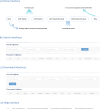TumorXDB: an integrated multi-omics xWAS/xQTL platform for cross-ethnic pan-cancer analysis
- PMID: 41029863
- PMCID: PMC12486755
- DOI: 10.1186/s12967-025-07029-6
TumorXDB: an integrated multi-omics xWAS/xQTL platform for cross-ethnic pan-cancer analysis
Abstract
Background: TumorXDB is a comprehensively curated tumor database integrating molecular association data (xWAS/xQTL) to explore genetic mechanisms across diverse tumors, organs, and ethnic groups. We aimed to provide a unified resource for discovering novel genetic associations and molecular mechanisms in tumors.
Methods: TumorXDB integrates four molecular-wide association studies (xWAS) and 23 molecular quantitative trait locus (xQTL) types spanning 10 physiological systems, 50 organs, and 139 cancer subtypes, while incorporating data from 25 ethnic subgroups across four major ancestral populations. To ensure data harmonization, we performed batch-effect correction using ComBat and applied the Benjamini-Hochberg (BH) procedure with false discovery rate (FDR) of < 0.05 for multiple testing correction. Meta-analysis models were developed to generate unified pan-cancer datasets, which are all accessible through a user-friendly web interface ( http://www.tumor-xdb.com ) with full data download capabilities.
Results: TumorXDB enabled robust integration of molecular data, revealing novel cross-cancer genetic associations through harmonized analysis.
Conclusions: This resource advances precision oncology by providing batch-corrected and statistically rigorous pan-cancer data for therapeutic discovery.
Keywords: Database; Multi-omics; Neoplasms; Population groups; Quantitative trait loci; Wide association study.
© 2025. The Author(s).
Conflict of interest statement
Declarations. Ethics approval and consent to participate: Not applicable. Consent for publication: Not applicable. Competing interests: The authors declare no competing interests.
Figures



References
MeSH terms
Grants and funding
LinkOut - more resources
Full Text Sources
Medical

